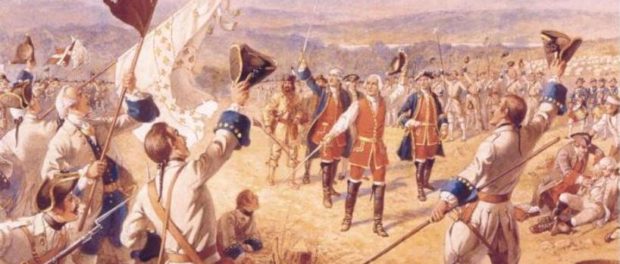1758: (One of) Two Ticonderogas & Other Quebec Curios
Part of “Je me souviens: New France, 1534–1763”
 "The Victory of Montcalm's Troops at Carillon" by Henry Alexander Ogden, now in the Fort Ticonderoga Museum in New York. Photo credit: Wikimedia Commons.
"The Victory of Montcalm's Troops at Carillon" by Henry Alexander Ogden, now in the Fort Ticonderoga Museum in New York. Photo credit: Wikimedia Commons.
While ensuing alliances were being made in Europe, the British and French were having their respective victories over in the colonies located in the New World. Two of these battles were called the Battle of Ticonderoga and occurred roughly a year apart.
The first Battle of Ticonderoga was in July 1758, though historians now generally call this battle the Battle of Carillon. Fought near present-day Fort Ticonderoga in present-day New York, the fort was actually built and occupied by the French. The fort was built in 1755, shortly after the beginning of the Seven Years’ War on the colonial side. Built strategically near Lake Champlain, it provided a view of the waters of the La Chute River. The River was treacherous but was the connecting point between the British and French trading routes. Its rapids were said to resemble the bells of a carillon, thus the French named it Fort Carillon.
The British decided it would be a good thing to try and take over Fort Carillon, and launched an offensive of fifteen thousand men, lead by what was supposed to be two men, James Abercrombie and George Howe. Howe was William Pitt’s preferred man to lead the attack, but political considerations made Abercrombie the lead man, with Howe backing him up. However, as the British landed on Fort Carillon, Howe was killed. With their second-in-command killed at the battle’s first advance, morale dropped. Abercrombie, an incompetent man all around, thought the battle would begin at 1 pm, but his various regiments started attacking at 12:30 pm. A regiment that had initially been placed as reserves apparently really wanted to fight and were allowed to join in as well with the regulars. During the battle, Abercrombie stayed towards the back of his army hidden in a sawmill as the British army fought for King and Country.
Fort Carillon’s defence was manned by a general named Louis-Joseph de Montcalm and aided by François de Lévis (the Chevalier de Lévis). Montcalm, sent to Carillon after a disagreement on Quebec City’s defences with General Vaudreuil, took command of less than four thousand men and set to reinforce the fort, albeit last minute. These reinforcements were camouflaged with shrubbery and provided enough coverage for the British to underestimate the French fortifications, leading them to believe the French were not as prepared as they were. During the battle, Montcalm fought alongside his troops, providing encouragement, and after the battle, provided his troops with beer and wine as a reward as they prepared for a British counterattack that never occurred.
Though the British outnumbered the French by about one to three, the British army were mercilessly slaughtered and eventually were forced to retreat. Abercrombie’s battle planning was considered an epic fail and received a letter from William Pitt saying that the King thought he “might” like to come home.
The other Battle of Ticonderoga occurred in 1759, and unlike the Battle of Carillon, was an English victory. Manned by Jeffrey Amherst, whose name will recur in Quebec’s history after the Conquest, manned this attack. But that’s another story for another week.
If you’re in the New York area next year, you can witness the (re-enactment of the) Battle of Carillon for yourself at Fort Ticonderoga. Learn more here.





